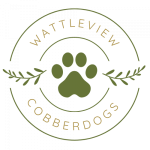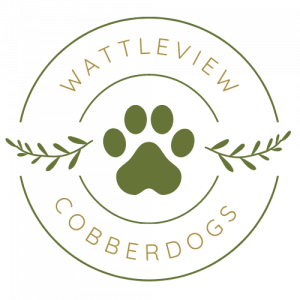

When our Wattleview Cobberdogs are puppies, we follow a comprehensive puppy curriculum to ensure our puppies are as adjusted, emotionally intelligent, intuitive and adaptive as possible.
We raise our Australian Cobberdogs in line with Puppy Culture principles, Badass Breeder protocols and assess them for traits and characteristics before allocating them to their forever families.
When our Wattleview Cobberdogs are puppies, we follow a comprehensive puppy curriculum to ensure our puppies are as adjusted, emotionally intelligent, intuitive and adaptive as possible.
We raise our Australian Cobberdogs in line with Puppy Culture principles, Badass Breeder protocols and assess them for traits and characteristics before allocating them to their forever families.
“Puppies are raised to believe in themselves and be the best they can be through guiding emotional responses, meeting their innate needs in order, building confidence through intentional and purposeful curriculum and handling that aligns to their sensitive developmental benchmarks and lastly evaluating each puppy prior to placement to ensure their voice is heard and they are honoured and respected not only with their breeder but with their new human as well.” Jeanette Forrey, 4E Kennels.
We raise our puppies in line with this comprehensive program developed by Jeanette Forey of 4E Kennels. This is referred to as the Badass Breeder program. We are proud to be apart of a progressive group of breeders who are striving to raise puppies in the best possible environment and honour their needs in their new homes by placing puppies according to their temperament test results and observed characteristics.
In the early weeks, we conduct gentle handling exercises and exposure to various scents (more information below). This helps ensure optimal development of the olfactory and nervous systems. We also condition them to the smell of our breath and the sound of our heartbeat (mandatory puppy cuddles).
Once puppies reach three weeks of age, they move to a more active area of our home. Their living area increases in size, toys are introduced and we begin the foundations for toilet training as well. As the puppies grow and develop we reduce the toilet area and increase the play space! We also start exposing puppies to new toys and sounds each and every day. We aim for them to interact with something new and different each day. This includes new objects, surfaces, textures and sounds every day.
We also begin exposure to both sleeping crates and flight crates from ~4 weeks of age. We place both items in the puppy area with doors open so that puppies can play, eat and sleep in these spaces every day. By the time they are ready to leave, any puppies flying are comfortable sleeping in a travel crate and the foundation for crate training has also begun.
Toilet training foundations begin at three weeks as well. We provide our puppies with a toileting framework that ensures they succeed in toileting where they need to from as young as three weeks of age. By the time our puppies leave us, they have learnt to use artificial turf when inside and have developed a preference to toilet outside wherever possible.
As the puppies get older, the exposure items also get more complex. We begin to challenge the puppies each day and we monitor their response to these challenges. This exposure curriculum ensures our puppies leave us as confident and resilient as they can be. You can see some of what we do on our social media channels.
Early Neurological Stimulation (or ENS) in its beginnings, formed part of the canine development program for the US Military. In an effort to improve the performance of their working dogs, the US Military developed a program called “Bio Sensor” later known as the “Super Dog” program.
Following on from years of research, the US Military learned that specific movements performed in specific windows of development could have long lasting and positive effects on their puppies. Over time, these movements have been refined and shared amongst the canine breeding world. ENS is a series of 5 simple but precise and controlled movements that are carried out between days three and 16 for each puppy.
When performed correctly, ENS is thought to provide the puppy with an early gentle stress response which better increases their ability to learn and cope successfully with stress later in life.
We perform ENS on all of our Australian Cobberdog puppies and have seen the difference it makes firsthand. When studied previously, ENS results in:
The strongest sense in dogs is their sense of smell or their olfactory system. Despite being born blind and deaf, their sense of smell develops rapidly and even begins prior to birth.
Early Scent Introduction (or ESI) is the introduction of a new scent daily (from days 3-16) to each puppy. Each day, a different scent is held within a few centimetres of the puppy for 3-5 seconds. We look for one of three responses:
We introduce a variety of scents including many items from the kitchen as well as items they will regularly encounter including tennis balls, grasses, flowers etc. We do not use items considered food for our dogs nor any chemicals. The responses are recorded against each individual puppy.
Limited studies have indicated that puppies exposed to ESI during the critical period of days 3-16 better develop their olfactory system and these dogs go on to have stronger scenting ability (particularly important for Cobberdogs in working roles such as Diabetic alert dogs).
We conduct this alongside ENS to increase and promote neuroplasticity in young puppies and better prepare our puppies for working roles and everyday life. Neuroplasticity is the term used to describe the brain’s ability to change over time.
All of the responses to ESI and ENS as well as our comprehensive and controlled exposure to a variety of sights, sounds, surfaces and items over the first eight weeks of life are recorded in our puppy software and this information can be provided to new families of our puppies.